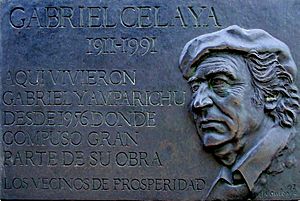Gabriel Celaya facts for kids
Quick facts for kids
Gabriel Celaya
|
|
|---|---|

Commemorative plaque at his Madrid residence
|
|
| Born | Rafael Gabriel Juan Múgica Celaya Leceta March 18, 1911 Hernani, Gipuzkoa, Spain |
| Died | April 18, 1991 (aged 80) Madrid, Spain |
| Language | Spanish |
| Nationality | Spanish |
| Period | 20th Century |
| Genre | Poetry |
| Notable works | Open World |
Gabriel Celaya was a famous Spanish poet. He was born in Hernani, Gipuzkoa, Spain, on March 18, 1911. His full name was Rafael Gabriel Juan Múgica Celaya Leceta. He later moved to Madrid to study engineering. For a while, he even managed his family's business.
Contents
Becoming a Poet
Around 1927, Gabriel Celaya met important writers like Federico García Lorca. These meetings inspired him to start writing. By 1935, he decided to focus completely on poetry.
In 1946, he started a collection of poems called "Norte" with Amparo Gastón. She was a very important person in his life and work. After this, he left his engineering job and the family business to become a full-time poet.
The "Norte" collection aimed to connect Spanish poetry with new ideas from Europe. It also tried to link different styles of poetry from that time.
Early Works and New Ideas
In 1946, Celaya published a prose book called "Tentativas." This was the first time he used the name Gabriel Celaya. His early work often explored ideas about life and existence, a style known as existentialism.
Gabriel Celaya believed poetry should be for everyone, not just a few people. He wanted poetry to help "transform the world." He shared this idea with other poets like Eugenio de Nora and Blas de Otero.
In 1956, he won the Critics Award for his book "De claro en claro." This was a big achievement for him.
Changing Styles
Later, when the idea of "social poetry" became less popular, Celaya went back to his earlier poetic style. He published "La linterna sorda" and re-released some of his poems from before 1936.
He also experimented with new forms of poetry. This included experimental poetry and concrete poetry, which focuses on how words look on the page. An example of this is his book "Campos Semánticos" from 1971.
Later Life and Legacy
Between 1977 and 1980, all of Gabriel Celaya's collected works were published in five volumes. This was a huge collection of his poetry and other writings.
In 1986, he received a national prize for Spanish literature. This award came from the Ministry of Culture. In the same year, he published a book called "Open World."
Gabriel Celaya's work is like a summary of many different styles and ideas in 20th-century Spanish poetry. He explored many themes and used various writing techniques.
He passed away on April 18, 1991, in Madrid. His remains were scattered in his hometown of Hernani.
Main Works
Gabriel Celaya wrote many books of poetry, essays, and prose. Here are some of his most well-known works:
- Poetry
- Marea del silencio, 1935
- La soledad cerrada, 1947
- La poesía es un arma cargada de futuro, 1954
- Cantos iberos, 1955
- De claro en claro, 1956
- El corazón en su sitio, 1959
- Poesía urgente, 1960
- La linterna sorda, 1964
- Campos semánticos, 1971
- El mundo abierto, 1986
- Essays
- El arte como lenguaje, 1951
- Poesía y verdad, 1959
- Exploración de la poesía, 1964
- Prose
- Tentativas, 1946
- Lázaro calla, 1949
- Memorias inmemoriales, 1980
Images for kids
See also
 In Spanish: Gabriel Celaya para niños
In Spanish: Gabriel Celaya para niños


